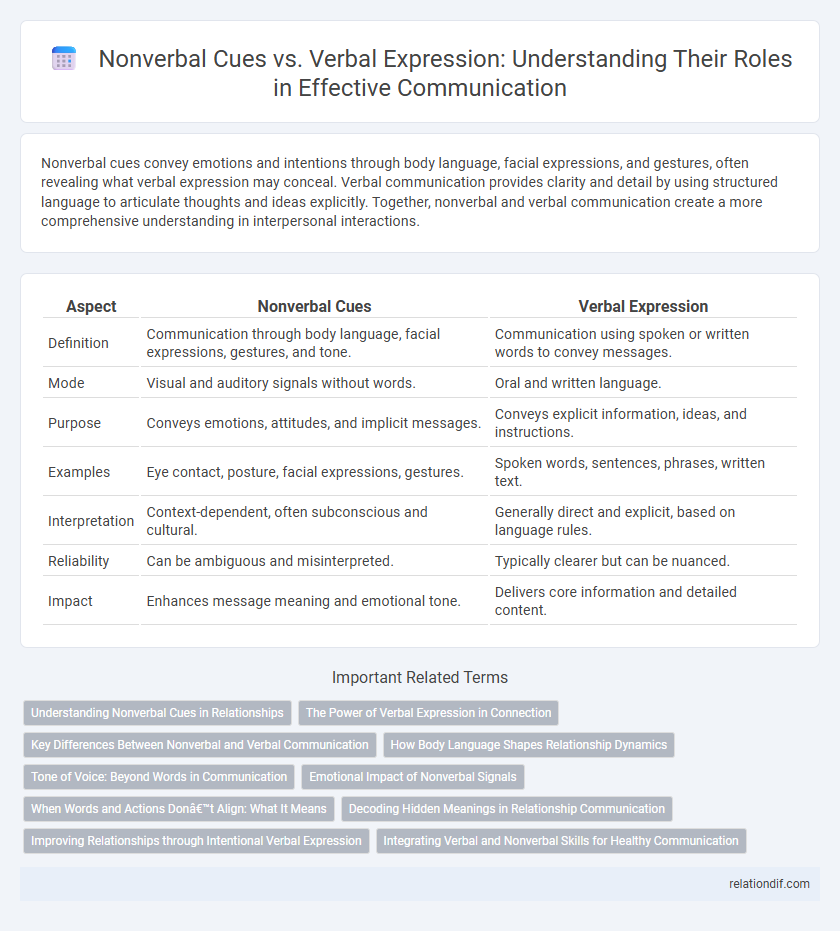Nonverbal cues convey emotions and intentions through body language, facial expressions, and gestures, often revealing what verbal expression may conceal. Verbal communication provides clarity and detail by using structured language to articulate thoughts and ideas explicitly. Together, nonverbal and verbal communication create a more comprehensive understanding in interpersonal interactions.
Table of Comparison
| Aspect | Nonverbal Cues | Verbal Expression |
|---|---|---|
| Definition | Communication through body language, facial expressions, gestures, and tone. | Communication using spoken or written words to convey messages. |
| Mode | Visual and auditory signals without words. | Oral and written language. |
| Purpose | Conveys emotions, attitudes, and implicit messages. | Conveys explicit information, ideas, and instructions. |
| Examples | Eye contact, posture, facial expressions, gestures. | Spoken words, sentences, phrases, written text. |
| Interpretation | Context-dependent, often subconscious and cultural. | Generally direct and explicit, based on language rules. |
| Reliability | Can be ambiguous and misinterpreted. | Typically clearer but can be nuanced. |
| Impact | Enhances message meaning and emotional tone. | Delivers core information and detailed content. |
Understanding Nonverbal Cues in Relationships
Nonverbal cues such as body language, facial expressions, and eye contact convey emotions and intentions more accurately than verbal expression, playing a crucial role in relationship dynamics. Understanding these cues helps individuals interpret unspoken feelings, build trust, and resolve misunderstandings effectively. Mastering nonverbal communication enhances emotional connection and promotes healthier interpersonal relationships.
The Power of Verbal Expression in Connection
Verbal expression enables precise communication of complex ideas, emotions, and intentions that nonverbal cues alone cannot fully convey. The use of tone, pitch, and choice of words plays a crucial role in establishing trust and clarity in interpersonal connections. Effective verbal communication fosters deeper understanding and strengthens relationships by explicitly articulating thoughts and feelings.
Key Differences Between Nonverbal and Verbal Communication
Nonverbal communication relies on body language, facial expressions, gestures, and tone of voice, conveying emotions and attitudes without words, whereas verbal communication utilizes spoken or written language to transmit explicit information and ideas. Nonverbal cues often provide contextual or emotional meaning that complements or contradicts verbal messages, affecting the interpretation and effectiveness of communication. Understanding the distinctions between these two modes is essential for enhancing interpersonal interactions and ensuring message clarity.
How Body Language Shapes Relationship Dynamics
Body language plays a critical role in shaping relationship dynamics by conveying emotions and intentions that words alone cannot express. Nonverbal cues such as eye contact, facial expressions, and posture often reveal true feelings, influence trust levels, and enhance emotional connection between individuals. Understanding and interpreting these signals accurately fosters deeper empathy and strengthens interpersonal communication.
Tone of Voice: Beyond Words in Communication
Tone of voice conveys emotions and intentions that words alone may not fully express, playing a crucial role in effective communication. Variations in pitch, volume, and pace influence how messages are interpreted, often revealing underlying feelings or attitudes. Understanding these nonverbal cues enhances clarity and fosters deeper connections beyond spoken language.
Emotional Impact of Nonverbal Signals
Nonverbal signals, such as facial expressions, body language, and tone of voice, carry a substantial emotional impact often surpassing spoken words. These cues can convey empathy, anger, or enthusiasm more authentically, influencing emotional perception and interpersonal connection. Research shows that up to 93% of emotional communication is transmitted nonverbally, underscoring the power of nonverbal cues in human interaction.
When Words and Actions Don’t Align: What It Means
Nonverbal cues often reveal true emotions when verbal expressions contradict them, indicating underlying feelings or intentions that words alone may obscure. Discrepancies between spoken language and body language can signal deception, discomfort, or ambivalence, prompting listeners to evaluate context carefully. Effective communication requires attentiveness to both verbal and nonverbal signals to accurately interpret meaning and emotional states.
Decoding Hidden Meanings in Relationship Communication
Nonverbal cues such as facial expressions, body language, and tone of voice often reveal underlying emotions and intentions that verbal expressions may conceal. Accurately decoding these nonverbal signals enhances understanding and trust in relationship communication by uncovering hidden meanings behind spoken words. Mastery of both verbal and nonverbal decoding skills leads to more effective conflict resolution and deeper emotional connections between partners.
Improving Relationships through Intentional Verbal Expression
Intentional verbal expression enhances relationships by providing clarity and reducing misunderstandings that often arise from ambiguous nonverbal cues. Clear articulation of thoughts and emotions fosters trust and empathy, strengthening interpersonal connections. Prioritizing precise language and active listening cultivates a supportive communication environment essential for healthy relationships.
Integrating Verbal and Nonverbal Skills for Healthy Communication
Integrating verbal and nonverbal skills enhances clarity and emotional connection in communication by aligning spoken words with body language, facial expressions, and tone of voice. Mastering this synergy reduces misunderstandings and builds trust, as listeners perceive congruence between messages and behaviors. Effective communicators analyze context, cultural norms, and feedback to balance verbal content with nonverbal signals, fostering healthier interactions.
Nonverbal cues vs Verbal expression Infographic

 relationdif.com
relationdif.com